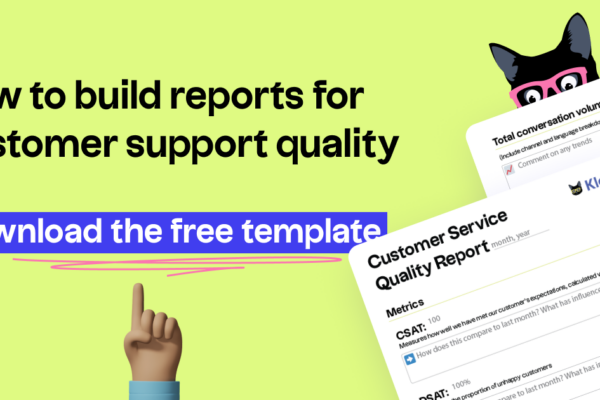Good mechanics hear the sound of a car engine and know when something’s wrong.
The best mechanics can diagnose the problem solely based on the engine’s sound. You might be at the repair shop for an oil change or a tire rotation, but one quick listen and they’re able to see three steps ahead to what you really need.
Your customer service department is that repair shop. Adopting a support-driven growth approach gives your support reps more power to drive revenue through their conversations. It equips them with tools to provide help and resources your customers might not even know they need.
Sound too good to be true?
We’ll let the cat out of the bag for you.

What is support-driven growth?
In practical terms, it expands the customer service team’s role in an organization.
Rather than only focusing on reactively answering questions and solving problems, a growth-oriented support team tries to create additional value for customers within every support interaction. It’s an approach that directly impacts your company’s bottom line.
Support-led growth can work for a range of companies. For example, say you:
- Offer a free trial for your product, or
- Follow a freemium model, where your goal is to convert free users into paying customers, or
- Have multiple paid plans that appeal to different buyer personas.
In all three situations, you have the opportunity to engage and upsell your customers. You’re likely already looking for opportunities to engage customers in ways that create value for them and lead to growth for your business (and if you’re not thinking about this in customer support, odds are your marketing and customer success teams are spending a lot of time thinking about it).
Support-driven growth asks: What about all the customers already reaching out to your support team every month?
Not making the most of those interactions is a huge missed opportunity.

Support-driven growth will have natural knock-on effects across other parts of your company
- Product teams should look for ways to create deal-breaker features that result in high churn rate.
- Sales teams need to implement value-based selling principles, such as an education-first approach.
- Engineer teams should prioritize the biggest pain points, as indicated in your customer support tickets.
By definition, support-led growth is something that chiefly involves your support team. But in reality, it’s an approach that promotes customer-centricity across your entire organization, helping keep clear focus on what success looks like for your customers and how you can get them there.
It starts with customer service teams, but it doesn’t end there.

The benefits of support-driven growth
Companies with a subscription model take, on average, 11 months to earn back their acquisition cost and start seeing a return on investment.
This is a prime example of why support-led growth can have such a massive impact on a business. Presumably, you already have a customer support team that delivers value to customers by helping them use your product.
By training your agents to deliver even more value, you can:
- Prevent churn
Identifying at-risk customers is its own art, but one potential subset is people who reach out to your support reps, especially if they’re angry or experiencing a major blocker. Enabling your customer service team to go the extra mile and support them—even beyond the specific problem they’re reaching out about—increases your chances of keeping that customer.
- Boost retention
Retention is the inverse of churn. Support-driven growth advocates for your customers to adopt a “Yes, and…” mindset, which encourages agents to offer help that a customer might not have even known they needed. It’s the difference between, “Yes, I can fix that for you” and, “Yes, I can fix that. Did you know you can also do XYZ with this feature?” When this is successful, it can drive growth, as well as more meaningful engagement with your product.
- Increase revenue
Lower churn and higher retention means more revenue and increased profitability. If your support team can have a positive and measurable impact on metrics like trial conversions in any way, your company benefits.
- Increase customer loyalty
Loyalty naturally increases when your customers are highly engaged with your product, use most of its features, and understand how to get the value from it. You can build deeper and longer-lasting relationships with your customers by using a support-led growth approach.
- Improve brand reputation
Reputation always sounds nebulous because it’s so hard to measure. You cannot succeed at support-driven growth without a stellar CS team that provides an outstanding experience. That impacts word-of-mouth recommendations and customer reviews.
- Increase the engagement of your customer service team
Support-led growth can be especially valuable to prepare your team for a recession and protect them during economic downturns. You already have a CS team spending all day responding to queries—this approach shifts them from being purely reactive to providing proactive benefits to your customers.
Your company benefits, your customers benefit, and your team benefits. It sounds like a purr-fect win-win-win for all, right?

How to implement support-driven growth
Support-led growth is indeed the cat’s pajamas—when you’ve done all the background work, training, and preparation needed to succeed.
Every change takes time and practice, but this one takes more. The real challenge to adopting a support-driven growth strategy lies in the implementation phase.
There are (at least) two necessary parties:
- Data analysts to identify conversion drivers.
- Your customer service team to creatively put those insights to work during support interactions.
You’ll also probably want someone to map out your ideal customer journey, but if you’re a support leader reading this, that person may be you (we’d suggest getting other internal teams involved too). Once you have these things available, you can start digging into the specifics.

7 actionable steps to get started with support-driven growth
- Understand your main conversion drivers.
- Measure how support engagement impacts business metrics.
- Design the ideal customer journey.
- Find opportunities to be proactive.
- Use the “Yes, and…” technique to provide additional value.
- Individualize your support interactions.
- Always lead with the solution.
Let’s dig into each one…
1. Understand your main conversion drivers
Support-led growth really only works when you know which factors positively impact conversion—whether you’re talking about converting from a free trial to a paid plan or from a basic plan to a higher-tier plan.
- Which features give your customers that “Aha!” moment that translates to a decision to buy?
- What are the signs of product engagement that result in customer retention?
- What are the points at which customers interact with your business that encourage them to purchase?
- Which customer segments are the most valuable for your business?
- Does any of your educational content (if available) drive conversions?
You can use this information to sketch out different journeys based on the conversion goals you want to target.

What that looks like in practice
Let’s take Zendesk as an example, focusing on their Zendesk Suite product. This is a hypothetical example, but we think it highlights the need to understand conversion drivers.
Zendesk’s typical journey for a new customer might look something like this:
The assumption is that these are the features a prospect needs to engage with before they’re likely to buy. That may be true—but which ones matter most? That’s where analysis comes in.
Maybe you find that creating ticket forms has the biggest impact on conversion. If that’s true, you’d want to guide customers to build ticket forms as soon as possible. When your support reps interact with a new trial customer that hasn’t created a ticket form, they could proactively share the value and guide the customer through the process.
Zendesk also provides courses, webinars, customer experience conferences, and reports. If you’re thinking about support-led growth, you could conduct analysis to understand how these different resources impact conversion rates.
By making it easy for your support reps to share the right resources at the right time, you’ll generate more engagement and value for those customers.

2. Measure how support engagement impacts business metrics
Another set of data that can make the light bulb go off when implementing support-driven growth is to compare engagement with support and your key business metrics.
Help Scout found that their most successful customers were:
- 300% more likely to be engaged with support pre-trial
- 300% more likely to be engaged with support in the 3-6 month range
- 240% more likely to be engaged with support 6+ months
In other words, analysis made them realize that their CS team played a massive role in their business, both in acquiring new customers and retaining them for the long haul. Even if there isn’t a proven causal relationship between these metrics, they clearly indicate that interacting with support usually leads to success for customers and the business.
Blending business metrics like conversion and revenue growth with other customer service metrics can also help here, but starting with something relatively clear cut—like how often customers contact support—is often hugely revealing.
3. Design the ideal customer journey
Now that you have the data, you can craft your ideal journey (adjusted for different customer segments). Getting clear on your customer experience enables you to use all the tools you have available to encourage customers along that journey.
Let’s look at our Zendesk example from above. Again, say the ideal journey is:
Maybe you’ve found that setting up an autoreply is the step with the highest failure rate. Setting up triggers in Zendesk can be quite complex, so your team could create in-app product tours or interactive guides to help customers through the process.
One other example: say when analyzing the journey, you see that customers are consistently getting stuck on creating views or ticket forms. That’s great feedback for your product team, but it’s also a prime opportunity to embrace support-led growth.
For smaller accounts, your support reps could proactively create one-too-many resources, such as knowledge base articles or webinars, that help customers overcome those barriers. For higher-value customers, you might opt to set up automated emails offering a one-on-one coaching session or onboarding call.

4. Find opportunities to be proactive
We’ve touched several times on how support-driven growth means taking a more proactive approach, but it’s worth calling out as its own point for emphasis.
The sky’s the limit when you’re on the hunt for opportunities to proactively engage with customers. Your analysis of conversion drivers should help you understand what to prioritize, but figuring out how to proactively help customers is often only limited by your own imagination.
Examples of proactive solutions:
- If a customer stops halfway through setting up a feature, trigger an email or in-app notification that sends them the relevant help guide.
- When they begin to disengage or veer off of the ideal journey, write tailored onboarding emails to help nudge each customer segment back on track.
- Create support tickets automatically and reach out if your product gives customers error messages. This can be especially helpful when they are early in their journey and at high-risk to churn (e.g., the first seven days after they create an account).
The point is to avoid waiting until customers reach out, because a good number of them won’t reach out—they’ll just drop out altogether. Proactive support is a great way to build customer loyalty and differentiate your brand as one that cares about helping customers be successful. It’s also a major example of the shift in mentality that has to happen for support-led growth to succeed.
5. Building on the “Yes, and” technique
Now it’s time for your support reps to really get their paws dirty.
“Yes, and…” is a technique from improv comedy. While your newest support agent doesn’t need to be the next Tina Fey, a deep understanding of this technique goes a long way towards helping your support reps contribute to growth.
In this case, the “yes” means helping the customer with the problem that made them reach out to you, followed by the “and…” which means providing additional value.
The idea is for every support agent to understand your customer’s journey and to guide them to take their next step.

How does that look?
Let’s take the SEO tool Ahrefs as an example. Ahref’s customers range from savvy SEO experts to brand-new bloggers. Here’s how they might use the “Yes, and…” technique to make customers more successful:
- A customer reaches out asking about their Keywords Explorer tool, which is used to research search traffic and competition for a specific keyword.
- The support agent quickly checks the customer’s website and notices they’d really benefit from a site audit.
- In their reply, they answer questions about Keywords Explorer, then offer up the link to using Ahrefs’ Site Audit and explain why it would help them.
The result? A happy customer who’s hopefully now even more engaged with their product and has seen even more value from Ahrefs. And all it took was some creativity and a few minutes of a support rep’s time.
It’s important not to approach this as if you’re selling something. You aren’t trying to get something out of that interaction. It’s all about your customer—you’re trying to give them additional help or to help them find additional value in your product or service.

6. Individualize your support interactions
Personalization essential for a great experience. Companies that offer personalized support are 2x more likely to report increased retention, brand loyalty, and satisfaction.
With a support-driven growth mindset, each ticket in your queue isn’t just a support ticket. It’s a unique customer and a real human.
Your support agents should see that ticket as a trigger to think about the customer, asking questions like:
- Who is this customer?
- What stage of the journey are they in?
- Where can they benefit more from using your product?
- Which features are they not capitalizing on?
- When might it make sense for them to try [this additional product]?
Take VidIQ as an example. Their primary customers are YouTube content creators.
- When someone reaches out to their CS team, they could quickly analyze their YouTube channel.
- In their response, they could include relevant educational content to help them grow their channel. They can also highlight unused features in VidIQ that this specific customer might benefit from.

6. Always lead with the solution
How a customer perceives an interaction is about twice as important as what they actually do during that interaction.
This is why positive positioning can be so powerful.
In support, the inclination is often to reply directly and concisely. If a customer asks about a feature that doesn’t exist, a typical reply might be, “That isn’t possible with our product now, but here’s a workaround.”
Framing the answer in this way highlights the negative. It’s focused on what you can’t do.
Instead, you can flip the script. A better alternative is to:
- Lead with the solution. Start by saying, “Here are some ways our customers solve this now.”
- Then directly respond to the question. After presenting the alternatives, you can openly and directly say, “We don’t offer a direct or native way to do this now.”
Educate the customer. If you don’t plan on developing that feature, use this as an opportunity to explain why your product team has made that decision to the customer.

Support-driven growth represents a change in mindset
Support-driven growth requires a change in mindset. It’s incredibly valuable for modern businesses, but it’s a different mode of operating as a support department.
Your support team members aren’t a bunch of robots (we hope!). You can’t just push a button and download a new operating system for them tomorrow. Take a measured approach towards changing the team mindset.
The support-driven growth initiative is an ongoing investment—one that will take time and resources, but will have a hefty payoff at the end of it.
The things your support reps do all day every day—responding to and helping customers—are still vital. That part of the job isn’t going anywhere. But a support-driven growth strategy pushes you to think about how your CS team can do more–be more proactive, add more value, and have more impact.
These are the types of changes that require an amazing training program and continuous reinforcement through great quality management.



